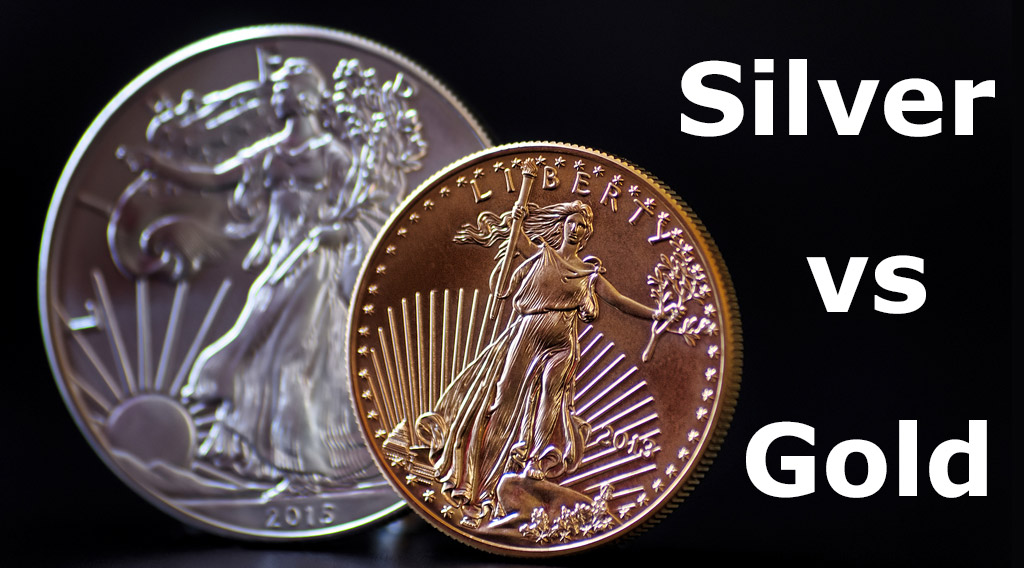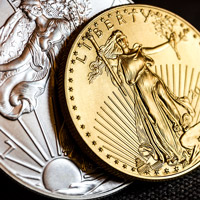 Gold and silver are the most popular precious metals investments by leaps and bounds. With millennia of documented use as currencies and stores of value, these physical assets have a strong reputation for their ability to preserve and build wealth.
Gold and silver are the most popular precious metals investments by leaps and bounds. With millennia of documented use as currencies and stores of value, these physical assets have a strong reputation for their ability to preserve and build wealth.
Given their comparative performance and demand, many investors wonder: Should I buy gold or silver? Although both metals offer considerable investment advantages, there are plenty of differences to take into account. Parsing these distinctions can help investors determine the best option for their investment goals.
Gold vs. Silver: Prices
One of the first differences investors notice is the stark gap between gold and silver prices. While gold and silver prices have recently notched historic highs, it’s important to keep in mind that although gold is technically more valuable than silver in prices-per-ounce, a commodity’s base price point doesn’t determine its entire investing merit.
There are several reasons why gold prices have remained higher than silver including its historical preference, relative scarcity, and the abundance of reserves around the world. As you’ll see, there are plenty of other factors to take into account when determining which precious metal might be ideal for you.
Gold vs. Silver: Accessibility
Silver’s lower price price point compared to gold can mean a lower barrier of entry for investors looking to buy 1 oz at a time. This is an attractive feature for novice or budget-conscious investors who are eager to diversify their portfolios without overextending themselves. However, gold’s higher cost-per-ounce can easily be overcome by investing in fractional gold.
These bars or coins weigh less than one troy ounce which is the traditional size for most precious metals assets. For example, 1/2 oz, 1/4 oz, 1/10 oz, 1/20 oz, and even 1/40 oz are possible fractional sizes. These smaller denominations provide investors of varying financial capacities with accessible options for incorporating gold into their portfolios.
Gold vs Silver: Market Size
The physical gold market, which is primarily comprised of central bank reserves, bullion bars, and coins, is estimated to be worth around $5 trillion. In comparison, the worldwide supply of physical silver is valued at roughly $27 billion. That means the gold market is well over 217 times larger than its silver cousin.
The vast difference in market size between gold and silver has several implications, especially regarding liquidity, volatility, and investment dynamics. For instance, gold’s larger market size can contribute to higher liquidity, which theoretically means it can be easier to buy and sell gold. At the same time, the silver market’s smaller size leads to quicker and more unpredictable price swings, although generally less volatile than the stock market.
Gold vs. Silver: Storage & Transportability
Storage is a crucial consideration for investors who want to take physical ownership of their tangible assets. Due to silver’s lower price point, any given value will take up considerably more room than its equivalent in gold. To put things in perspective, $10,000 of gold at current spot prices would weigh about the same as three golf balls while the same value of silver would weigh equivalent to two-and-a-half bowling balls.
Ease of transportation is another crucial distinction between gold and silver, given their widely varied price points. Silver’s lower cost average could hinder transportability when compared to gold, which might be an important factor to some investors. This makes it more difficult to securely and discretely move large quantities of silver assets.
Gold vs. Silver: Risk & Volatility
Both gold and silver maintain steady price action given their high demand, varied functionality, and long history as safe-haven assets. However, silver prices experience more volatility due to the relatively small size of the market. A combination of fewer traders and a lower base price means even incremental movements in the market can be reflected in sizeable price swings. In some instances, silver prices can be up to three times more volatile than gold prices.
Investors can effectively smooth out or nullify that volatility by dollar-cost averaging and holding assets for the long term. There are also many relatively lower-risk physical gold and silver options such as investment-grade coins or proof bullion coins. Don’t forget that physical precious metals are renowned for their inflation-hedge properties which means they’re inherently less risky and volatile than traditional assets such as stocks, bonds, or mutual funds.
Gold vs. Silver: Inflation Hedge
Historically, gold and silver have been revered for their ability to hedge against inflation and other economic pressures. This is primarily due to the inherent value of these precious metals which is derived from factors independent of the broader economy. Beyond mere protection, gold and silver are acknowledged for their tendency to increase in value as the traditional markets falter. Despite this shared security against inflation, gold and silver exhibit distinct characteristics in how they respond to economic changes.
Gold is considered the go-to asset for maximal protection during periods of sustained inflation. Its price stability, historical precedence, and widespread acceptance as a store of value have made it a favored choice among investors seeking protection. Although silver is a viable hedge against inflation too, its performance is slightly more unpredictable, influenced by its significant tie to industrial demand and greater market volatility.
Gold vs. Silver: Industrial Use
Precious metals hold practical merit in addition to their inherent value. Gold is renowned for its malleability and flexibility, while silver is desired for its reflectivity and high thermal and electrical conductivity. However, silver enjoys significantly more industrial demand due to a combination of widespread availability, affordability, and functionality. This shiny metal is most commonly used for electronics, batteries, and solar panels.
The shift towards green energy is a massive driver of the surging demand for silver – a trend that is expected to grow in the future.
Notably, a larger portion of total silver demand is driven by industrial application when compared to gold. As a result, silver prices tend to be more vulnerable to downturns in the broader economy. When challenging conditions lead to a drop in industrial demand, silver prices often see a slight

How Gold & Silver Are the Same
There are plenty of differences between gold and silver, but it’s their shared characteristics that highlight their enduring value and role in investment portfolios.
Physical Assets
One of the most important features shared by gold and silver is their tangible nature. Investors looking to secure their wealth against the instability and volatility of traditional markets look to precious metals because of their inherent value. The high fineness ratings, scarcity, numismatic appeal, and widespread recognition of physical gold and silver assets make them worthwhile investments independent of the broader market.
Asset Variety
Both precious metals offer investors a diverse range of asset types including bullion bars and coins and investment-grade coins. This variety makes it easier for you to find a format that suits your investment goals. Whether you’re to optimize your privacy and anonymity or financial security and wealth generation, there are gold and silver assets to help you achieve those goals.
Inverse Relationship to Economy
Physical gold and silver typically increase in value when the US dollar and other fiat currency-based assets lose value. This is precisely why these precious metals are effective hedges against dollar devaluation and inflation.
IRA Eligibility
Investors can shore up their nest eggs with gold and silver assets through a precious metals IRA. This special retirement account makes it possible to gain the tax-advantaged status of standard retirement plans while obtaining the inflation-edge properties of physical assets. The Internal Revenue Service places some restrictions on IRA-eligible metals based on purity, weight, and asset type.
Should You Buy Gold or Silver?
There’s no catch-all answer to this common investment question, just like there isn’t a cookie-cutter approach to investment strategy. In reality, there are circumstances where gold will be the ideal choice and other scenarios when silver takes precedence. In most cases, a healthy mix of both assets will provide the best combination of protection, growth potential, and anonymity for your portfolio.
Finding the right asset depends on your specific investment situation including goals, risk tolerance, budget, and more. That’s where a Precious Metals Advisor comes into play. These experts work one-on-one with investors to determine which gold and silver assets best align with their investing circumstances.
“[Precious metals advisors] customize a portfolio based on each person’s needs and wants. This is not a cookie-cutter approach.”– Precious Metals Advisor Richard Otto
Understand which precious metals meet your investment needs by requesting our FREE Precious Metals Investment Guide. It covers everything you should know about diversifying your portfolio with gold and silver for maximum protection, growth, and security.


